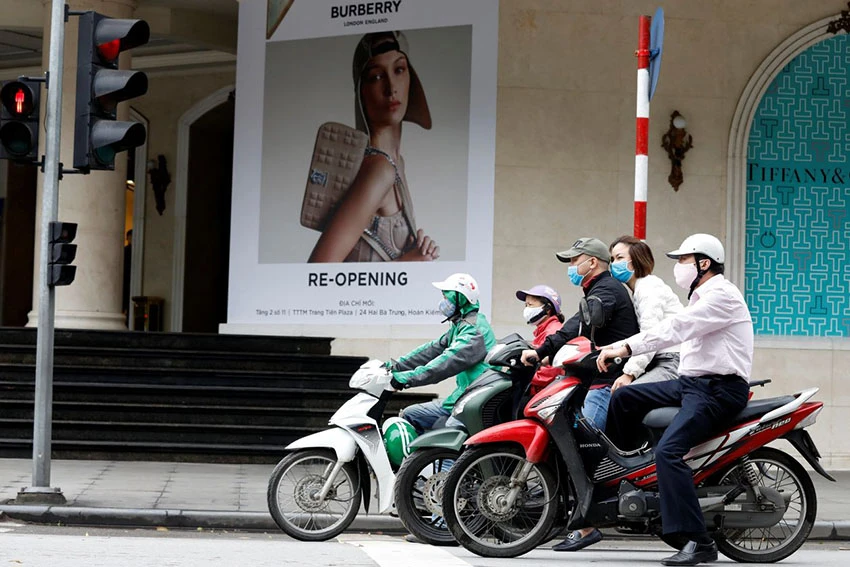
In January, when the world was starting to learn about the new coronavirus, Vietnam’s leader likened it to an enemy the nation must fight. Tens of thousands of people were quarantined in state-run facilities over the following months and entire villages locked down in response to even small clusters of infection.
Three months after its first case was detected, the Southeast Asian country appears to have beaten back the virus, at least for now.
Vietnam has reported just two new infections in the last 10 days, both students who returned from Japan last week. The country of more than 95 million people hasn’t reported a single death from the virus. Most of its 270 confirmed cases have recovered.
Stores and restaurants began reopening Thursday after the government eased three-week-old restrictions on movement. Cafes in the capital Hanoi offering noodle soup and coffee with condensed milk welcomed slow streams of patrons. Ride-hailing services became available again, while most of the country’s schools and karaoke bars popular among locals remained shut.
“We should not forget that we have only won individual battles, not the whole fight,” Deputy Prime Minister Vu Duc Dam said Friday as some countries, including Singapore in the region, confront new waves of infection after early successes.
Already a top choice for global manufacturers looking to diversify out of China, Vietnam’s response so far is likely to further boost its credibility, said Julien Brun, Ho Chi Minh City-based managing partner at CEL, which advises multinationals on emerging-market investments. Although factories in the country exporting clothes and shoes are currently reeling from massive cancellations of orders, more production across different sectors could move to Vietnam longer term, he said.
The developing country—lacking Singapore or South Korea’s resources—has tested more than 210,000 samples. That is a moderate number in relation to its population but high in the context of the size of its outbreak. Vietnam has conducted more than 780 tests per confirmed case, a higher figure than New Zealand or Taiwan, showing a vast proportion of its tests are coming back negative.
Crucial to preventing a large outbreak in Vietnam was an aggressive quarantine regime that involved housing tens of thousands of people in military barracks, university dormitories and other state-run centers. When a person was confirmed to be infected, many of their close contacts, including those showing no symptoms, were quarantined in state-run facilities or hospitals rather than their homes where they might infect elderly family members.
All those who returned to the country from overseas in the last month were also required to stay in these places for 14 days.
In early April, when the country had reported less than 250 cases, nearly 45,000 people were quarantined in government facilities. That number is now down to about 11,000, while just over 40,000 are isolated in their homes, comprising largely of the contacts of a confirmed patient’s close contacts.
The system relies on contact tracing to identify all those an infected person may have exposed. Health authorities publish widely read details of the person’s activities on government websites, newspapers and social media, for instance which restaurant they visited and how much time they spent at a market, urging people to come forward if they think they may have come into contact.
“Vietnam took very early and drastic actions,” said Le Hong Hiep, a fellow at the Singapore-based ISEAS-Yusof Ishak Institute. The reason, he said, was that Vietnam, a one-party state similar to China, better understands the workings of its neighbor’s political system and suspected early on that the coronavirus outbreak may be severe.
Last month, after a number of cases were linked to Hanoi’s Bach Mai Hospital, the facility was put under total lockdown for two weeks. Around 5,000 staff and patients were tested, as were thousands of others who had visited the hospital. Late March, Vietnam imported 200,000 rapid test kits from South Korea to ramp-up capacity.
At least 45 cases were found linked to the hospital and a company that supplies food to it.
When authorities learned a man from Hanoi’s outskirts had visited the hospital and tested positive, they sealed off the area where he lived and stationed law-enforcement personnel at entry points. His close contacts were dispatched to government facilities. Around 11,000 residents were tested, of which 13 came back positive.
That community is still under lockdown, among a handful of areas that aren’t yet returning to normal. Elsewhere, reopening rules differ from place to place. In some big cities, social gatherings of 20 or more remain prohibited.
A mall in southern Hanoi was open for business Friday, with the city’s recently inaugurated Uniqlo store—its first—attracting customers. Nguyen Huyen Trang, 25, who lives a short ride from Hanoi, stopped by to shop and later get some bubble tea nearby. With entry restrictions into the capital eased, she had ventured in for a medical checkup unrelated to the coronavirus, but the virus was on her mind.
“I don’t want to go out to the streets a lot around this time because I think it’s still dangerous,” Ms. Nguyen said. “If I let my guard down, the epidemic could come back any time.”




















